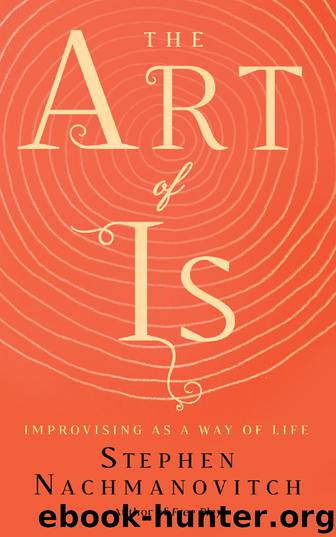The Art of Is by Stephen Nachmanovitch

Author:Stephen Nachmanovitch [Nachmanovitch, Stephen]
Language: eng
Format: epub
Publisher: New World Library
Published: 0101-01-01T00:00:00+00:00
Listening
Take a walk at night. Walk so silently that
the bottoms of your feet become ears.
— Pauline Oliveros
To improvise, listen. You need nothing else. A friend who runs a children’s theater came to a concert of improvised music. She later said that she had never seen two adults paying attention to each other as intently as she had that evening. When the music has no score, then listening is the score.
We listen not only with ears but through the full sensorium: eyes, nose, tongue, skin, body, mind. Muscles listen. Dianna Linden, one of the gurus of massage therapy, often spoke of palpatory intelligence — touching consciously, feeling the system of a particular body and adjusting accordingly. Evelyn Glennie, the world’s foremost classical percussion soloist, is deaf. She hears through the soles of her feet, her whole body. It is a remarkable experience to watch her give a master class in contemporary percussion. While following a score, she is intently perceiving the student’s sound, able to clue him or her in to hidden subtleties of expression.
Playing a violin or building one, playing with or building anything, we flow with a universe of feedback: kinesthetics, pressure sensitivity in the fingertips, temperature, the cochlear organ’s ever-shifting sense of balance, and sense modalities that have no name.
• • •
In a study published in the Annals of Internal Medicine in 1984, investigators timed how long doctors listened to a patient before interrupting. The average was eighteen seconds.
I often think back to a conversation with a dear friend, Michael Stulbarg, a pulmonologist at UC San Francisco, who died in 2004. In the mid-1980s I asked him, “What do improvisation and creativity mean to you, in medicine?” Michael was what we used to call a left-brained person: scientific, rational, and logical. But he responded without hesitation. He said that improvisation is seeing and dealing with the actual patient in front of you rather than “treating the chart.” Michael’s response gives new meaning to the job title attending physician. I’ve talked to doctors many times since then and have often gotten some variant on that answer. Improvising is the ability to approach an encounter with knowledge and skill but also to come empty and open — to empty yourself of knowledge and skill to the degree that your expectations do not prevent you from seeing what is in front of you. The structure of understanding coded in the textbook is vitally important; medicine is informed by statistical and normative research, but in each case that knowledge is being connected with a unique individual, an n of one. The physician Eric Cassell, who has written and taught extensively on the art of listening to and talking with patients, reminds us that every medical encounter is a theater piece played out between two or more unique human beings. He points out that conversation and listening are art forms that can be practiced and learned. Even if the standard diagnosis fits, you still have to see how it fits into the context of a particular person’s life.
Download
This site does not store any files on its server. We only index and link to content provided by other sites. Please contact the content providers to delete copyright contents if any and email us, we'll remove relevant links or contents immediately.
Rewire Your Anxious Brain by Catherine M. Pittman(18530)
Talking to Strangers by Malcolm Gladwell(13184)
The Art of Thinking Clearly by Rolf Dobelli(10174)
Mindhunter: Inside the FBI's Elite Serial Crime Unit by John E. Douglas & Mark Olshaker(9159)
Becoming Supernatural by Dr. Joe Dispenza(8088)
Change Your Questions, Change Your Life by Marilee Adams(7610)
Nudge - Improving Decisions about Health, Wealth, and Happiness by Thaler Sunstein(7541)
The Road Less Traveled by M. Scott Peck(7499)
The Lost Art of Listening by Michael P. Nichols(7387)
Mastermind: How to Think Like Sherlock Holmes by Maria Konnikova(7195)
Enlightenment Now: The Case for Reason, Science, Humanism, and Progress by Steven Pinker(7162)
Win Bigly by Scott Adams(7077)
The Way of Zen by Alan W. Watts(6479)
Daring Greatly by Brene Brown(6427)
Big Magic: Creative Living Beyond Fear by Elizabeth Gilbert(5575)
Grit by Angela Duckworth(5491)
Ego Is the Enemy by Ryan Holiday(5265)
Men In Love by Nancy Friday(5136)
Altered Sensations by David Pantalony(5029)
